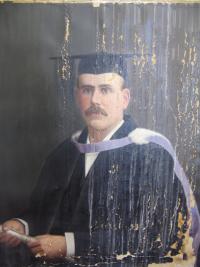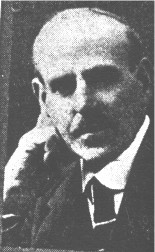Music
Midi files
Home
F.A. Challinor (1866-1952)
Biography
Few can have had such a difficult start in life as Frederick Arthur Challinor. He was born in 1866 to a relatively poor, working class family. The 1871 census records him as living with his grandfather, William, in Cinderhill – a mining area and at the time in the parish of Caverswall. His father was a coal pit banks man and a local Methodist Lay Preacher but not of any musical bent. His parents, Thomas and Anne, lived in the parish of Trentham – at 153, Howard Street. By 1881 Thomas and Anne with their children, Frederick, William, Thomas and Anne, ( 14, 12, 8 and 6 years of age respectively) had moved the the Croft, Audley and since Frederick had been obliged to leave school at the age of ten he went to work in a brick making factory. During the next two years he moved, successively, to a colliery weighing-house and then to labour underground. He stayed in the colliery until the age of fifteen and then, through the recommendation of an uncle, moved to work in the pottery industry. In 1886, on Christmas day, he married Annie Mabel Moore at St. Peter's church in Caverswall – a marriage that became increasing difficult with, it is said, Annie's shrewishness making life for the whole family unpleasant. The family separated – something not approved of by the Methodist Church, which may account for his neglect by the Church to which he gave so much service. By 1881, Frederick, Annie and their children (Frederick, 3yrs, Mabel, 2yrs and Ellen 1month) moved back to their home ground and were recorded as living at 177, Meir Road, Normacot, - within a few minutes walk of Cinderhill. The 1891census gives his occupation as Earthenware Potter's Slip Maker; his wife Mabel was an 'Assistant Schoolmistress' – at the time bright girls were kept at school and given work as school teachers and trained in service. By 1901 the family had moved to a nearby location, 51 Alexandra Road, their children include Frederick and Mabel but not Ellen, the youngest now being Arthur, aged 2. Challinor's occupation was described as 'teacher (of music)'.
His first musical ‘education’ came from a fellow worker at the pottery factory who had been an instrumentalist in a local workhouse band and he taught him the basics of music. Then there was a rare stroke of good fortune - his family received a bequest which included a piano which was to stimulate musical studies considerably. He acquired Alfred Robert Gaul’s book on harmony which he studied at home and without great success - never proceeding beyond the common chord. At the time Gaul’s choral music was enjoying substantial popularity and it must have been a great frustration to the keen and energetic Challinor that he could not emulate his mentor. As money became available he took private lessons in harmony and allied musical theory. From this point all his free time was taken in musical study and in ten weeks he had completed all the exercises in Stainer’s Harmony Primer. All this took place while he was working and he was ridiculed by his fellow labourers who tried to prevent him from continuing but he had the strength of character not to follow the herd but to pursue his desired task. After only one year of formal teaching he passed the local Royal Academy of Music examination and two years later entered for the Associate of the Royal College of Music examination. On the first day of this test, which included harmony in five parts, counterpoint, fugue, canon, instrumentation and musical form, he acquired so many marks that he had passed and was not required to take the oral section.
He next turned his attentions towards obtaining a degree in music and bought the necessary books for study, however, he still had his daily work in the pottery factory and the difficulties became so great that he had to suspend his studies. By now he had gathered a ‘school’ of pupils and so, as time went by, he was able to concentrate more on music and so give up his work in the potter industry and become a full time music teacher. He began to work again on his degree studies and by 1897 had passed his final examination. The composition he submitted to Durham University for his B. Mus. degree was ‘A Song of Praise’ which had the first line ‘O give thanks’ and is a setting for treble, alto, tenor and bass, 2 violins and ‘cello. He then composed numerous anthems, part songs and cantatas and had the good fortune to have them published. At the time the Potteries area was a ‘hot bed’ of music with many fine choirs and much music making (the first successful performance of Elgar’s ‘Dream of Gerontius’ and the first performance of his ‘King Olaf’ took place in Hanley and the WB of the ‘Enigma Variations’ lived in Fenton). The Potteries Choral tradition required a constant supply of new music and he produced cantatas such as Judah in Babylon, The Gardens of the Lord, Bethany, The Journey of Life, and The Story of Jesus also he never lost his understanding of the child mind and composed many hymns for Methodist Sunday Schools.
The degree of Bachelor of Music was but the initial step required to reach his goal of Doctor of Music and in 1903 he was awarded the Mus.Doc. degree at Durham University. It is said that he cycled to and from Durham when he went to receive his doctorate. The work he submitted for his doctorate was ‘Light in Darkness’ in six sections - Overture, Octet, Choral Recitative, Soprano Solo, Introduction and Fugue. The Overture was performed many times in Llandudno and Bournemouth by the pier light orchestras.
Early in 1903 the composer was deeply troubled by a set of adverse events which had overcome him. He was unable to sleep and rose about 3am and took up a poem by Henry Branch named ‘Sunset’ - by 6am the words were set to music and the score virtually complete. Challinor considered this work to be his most individualistic part song, which, whenever he heard it performed, brought back the feelings of anxiety which were the cause of its composition.
By 1905 he had over 400 pieces published - he was able to compose rapidly when the mood took him - one his most popular melodies ‘Shirley’ was composed in four minutes while awaiting the arrival of a late pupil. He was awarded prizes for a competition organised by the London Sabbath School Union which were completed the day before the last date for entry. Sir Frederick Bridge (1844 - 1924) awarded him first prize in the two categories the works had been entered.
He was also a capable poet writing words under a nom de plume for around 40 hymns which he set to music.
In 1929 he composed ‘The Potter’s Song’ for the Potter’s Choir and presented the autograph manuscript to William Milner who was President of the Longton Lodge of the National Society of Pottery Workers.
In 1930 there was a Stoke-on-Trent Pageant and Josiah Wedgwood Centenary Celebration for which he wrote the words and music for a choral prologue ‘Ode to Art’. It was performed in Hanley Park in the summer of 1930, however, the only comment we have about this work was that it was ‘delightful’. In 1930 he retired to Paignton and died there on 10th June, 1952. He is buried in Paignton Cemetery. Philip Carter, the MCMS Library Liaison Officer, has informed me that he could find no evidence of Challinor having taken any active part in either the Methodist Churches in Paignton or the local Choral Societies.
Nearly all the information we have concerning Dr. Challinor is from the ‘Musical Messenger’ Vol. 1 No. 2 June 1905 page 25. The later notes on his life including those in the ‘Evening Sentinel’ of 1955 by R.D. Woodall and those of January 6th 1959 contain little information that is not available from ‘Musical Messenger’. Mary Wilkinson Freeman in her chapter on the composer in ‘The Story of Normacot’ uses MM as a principal source but adds anecdotes from his granddaughter. There are also notes in ‘Music of the Methodist Hymn Book’ 858 and ‘The Story of Etruria’. Challinor’s contribution to music in the Potteries is recorded in ‘Music in the Five Towns 1840 - 1914’ by Reginald Nettel who pointed out that Challinor was eclipsed because of the ‘big names’ (Elgar, Delius, Sir Thomas Beecham and Havergal Brian) who were music making in the Potteries and because of his association with Sunday School Anniversaries. Nettel wrote ‘. . . . F.A. Challinor who started life as a pit boy and became doctor of music. Such a distinction is not unique by any means. Many a young fellow in the ‘eighties and ‘nineties succeeded in taking external degrees in music at Oxford or Durham Universities who worked at one point in heavy industry. Dr Henry Coward, of Sheffield , is a case in point. Coward, however, found his niche as a conductor, while Challinor took to composition. Challinor believed in the smaller types of choral song - a choice which proved detrimental to popularity. Challinor was a man of simple tastes, he had a love of children’s music, and devoted much of his early life to the composition of two part songs for schools. This had an unfortunate effect on his reputation in that he acquired in a short time a fairly wide public made up entirely of Sunday School Anniversary audiences. No doubt it was a good thing in its way that he found favour with this public, for it provided him with a certain modest income which enabled him to devote some time to the composition of part -songs. One of the first of these, called ‘Evening’ , he dedicated to James Garner and the Hanley Glee and Madrigal Society, and it found a place in their programme in 1895. Another, ‘Is my lover on the Sea?’ was sung by the North Staffordshire District Choral Society in 1909, and as late as 1930 he was chosen to to compose an ode for the Josiah Wedgwood Bicentenary Celebrations at Hanley, but he never thrust himself to the fore, and the Potteries was concerned with bigger game throughout the the critical years of Challinor’s development. He remained, therefore, a composer of children’s songs, and failed to bring to bear on the district of his birth the influence that a more forceful personality might have exerted. He is best remembered for his tune ‘Shirley’, set to the popular hymn ‘For the Beauty of the Earth’.
The music he submitted to the University of Durham for his degrees is still in the library there. Refs. Music Exercise 95 (B.Mus), Music Exercise 182 (D. Mus.) - Personal Communication from Miss E. Rainey, Sub-Librarian.

Publications in the
British Library's Printed Music Collection
Music in the estate of the late Mrs Brenda Walsh of Werrington
Music in the library of the Wedgwood Memorial College, Barlaston
Music Illustrated in 'The Story of Normacot'
Congregrational Hymnary
G. Schirmer of New York
 Click this picture to enlarge it
Click this picture to enlarge it